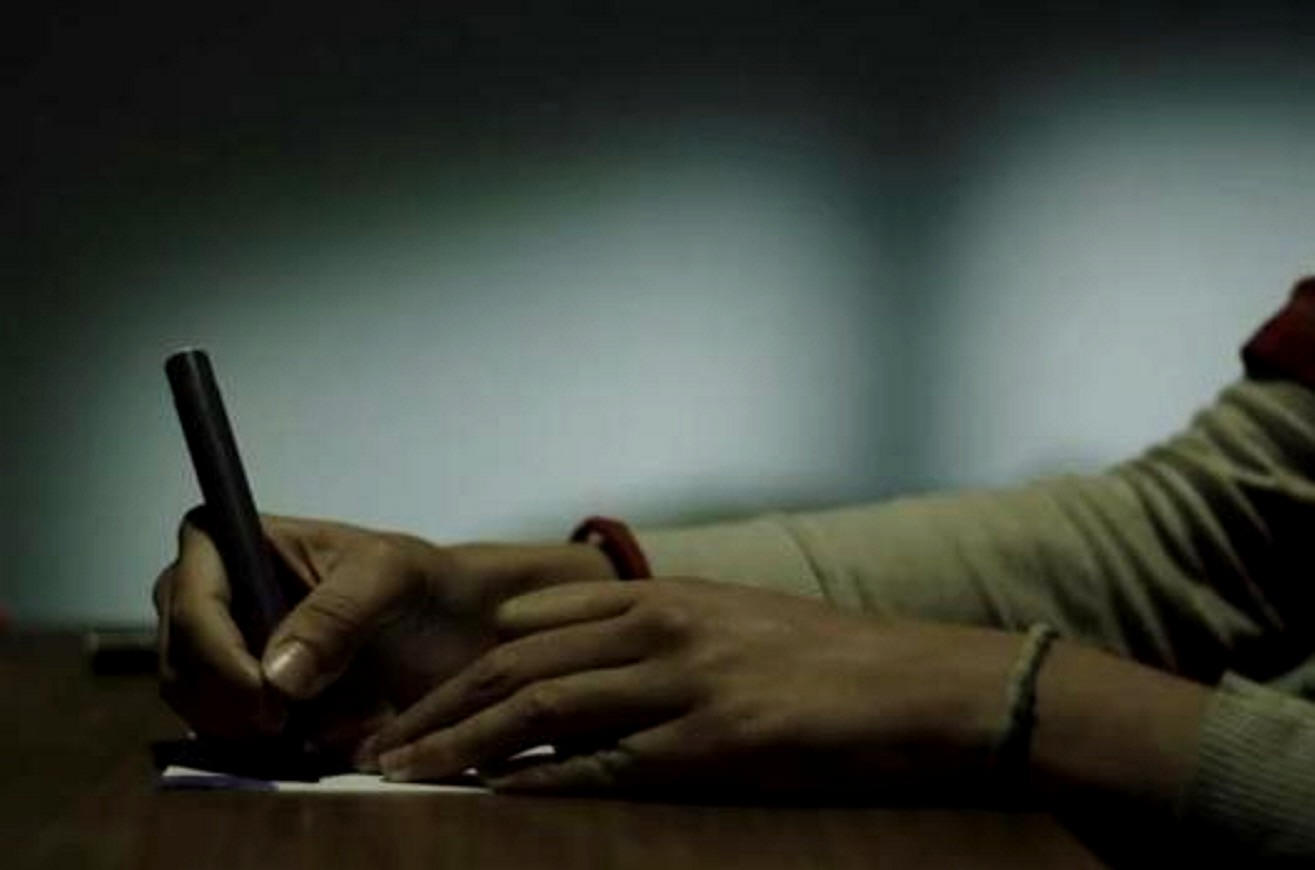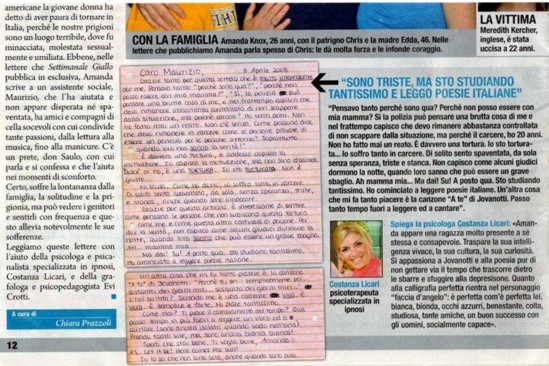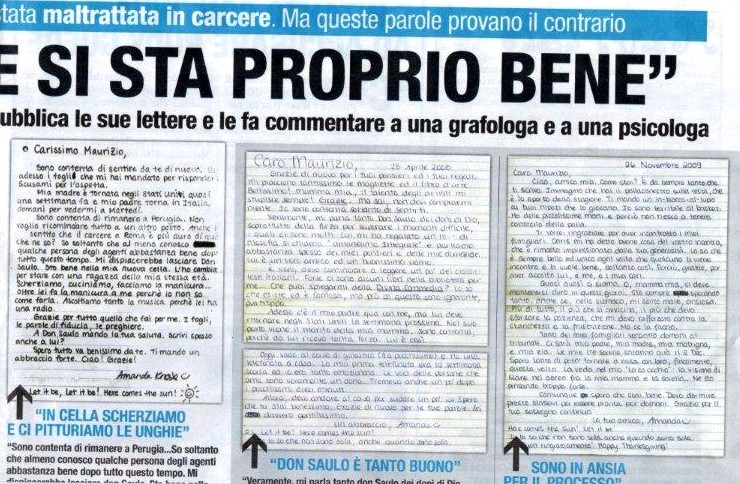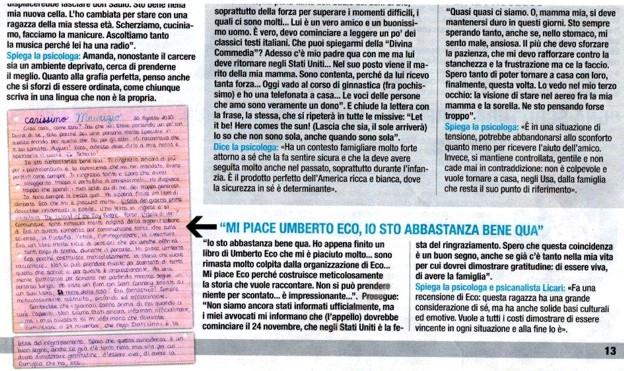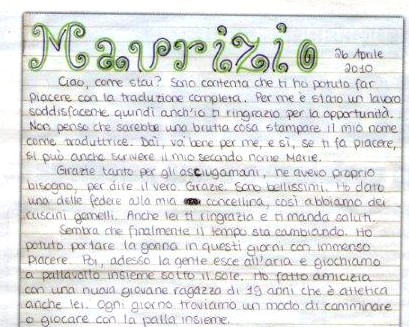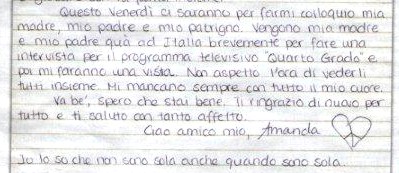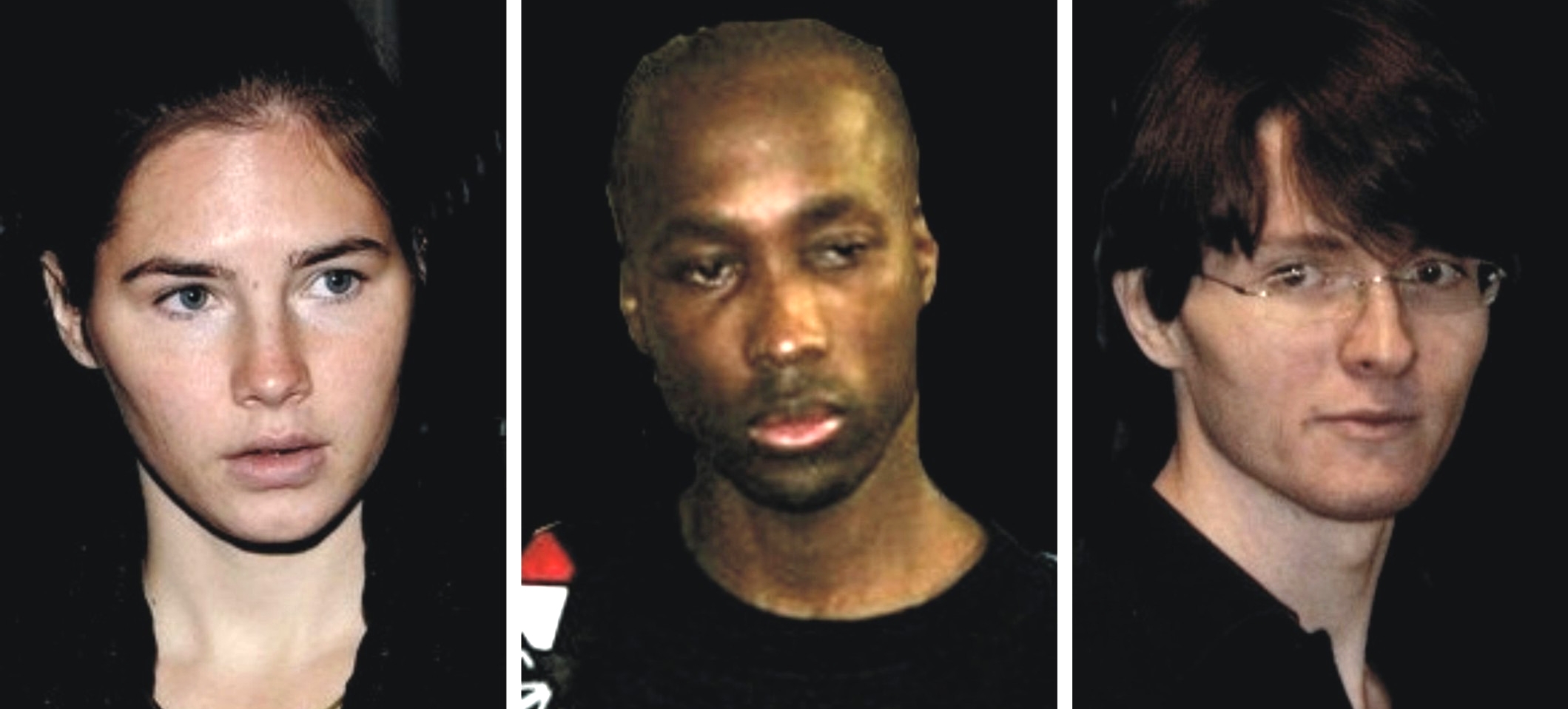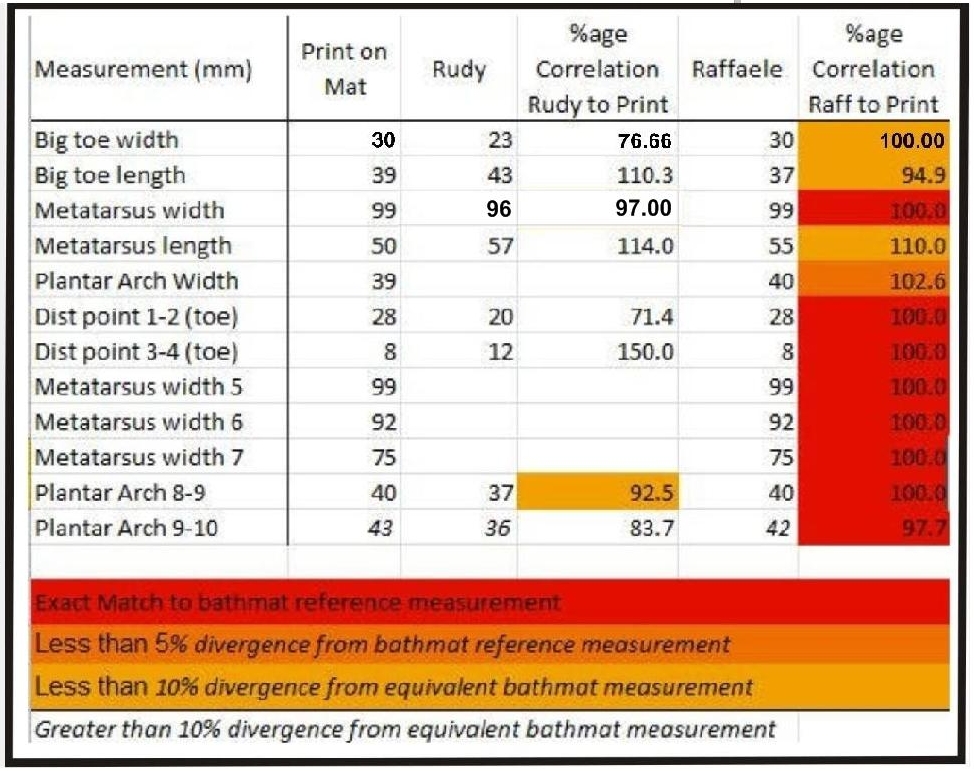
Category: Hoaxes Knox & team
Friday, May 31, 2013
Knox Book - What The Newly Published Writings Reveal To Professional Eyes (2)
Posted by SeekingUnderstanding
The New Writings
It is good to have an opportunity to see the letters from Amanda to her social worker, Maurizio. The writing style is very different from her book which seems more abrasive, more ‘jazzed up’, pointed, in comparison - presumably the influence of the ghost writer.
What is immediately and conspicuously obvious is that the letters make no mention of ill-treatment - a contrario in many ways. The recipient of the letters is someone whose support she needs, as is Don Saulo.
She goes out of her way to speak to them with endearment, even flirtation, to show gratitude, to build trust, or to appear to build trust. This is a person whose need to be liked and supported is paramount. One has the feeling, therefore, that she is presenting herself in the best possible light.
This includes being ‘good’ and saying things as they are. And they are: ‘OK’, ‘fine’, ‘bene’, ‘well enough’, ‘happy to remain’ (in Perugia) etc.
There has been much speculation about the psychology of Amanda Knox. I am glad to say that this site has deferred, by and large, from assigning labels to her. It is not for nothing that the official court psychological profiles of 2008 have not been disclosed. To begin with, a full analysis is not possible without personal encounter. And then there is the question about the value of such labels at all, especially with new research advancing all the time.
However, one can talk about observable patterns of behaviour, for example narcissistic behaviour. There are a number of established, well-researched traits in narcissistic behaviour which are worth discussing here.
Observable Behaviors
I believe the following characteristics have been observable and continue to manifest in the letters just published. These are :
- 1) Immaturity, of a degree which indicates some arrested emotional development. And connected to this, an emotional neediness and dependence. This usually manifests as insecurity where it becomes important that everyone has to like, admire, and feel affection for them - most especially those who they need to ‘look out for them’, be their support system etc. A secure personality has a healthy ego which can quietly use reasonable judgement, and only needs to be assertive where occasion demands. An insecure person has a weak and fragile ego, contrary to the appearance they try and give, which can be loud, over-confident and assertive, or proud etc.
2) An inability to deal with shame, or admit guilt. This also connects with (in Jungian terminology) an inability to ‘own the shadow’, and admit one can and does sometimes make mistakes. The cultivation of a false sense of self or identity follows; an image projected of the ‘angelic’,‘innocent’ - always sunny and light, and, ‘special’ (cf : ‘here comes the sun’ as a mantra). Of course, a PR campaign can proliferate this advertising of the false image, and this is precisely how ‘celebrities’ make use of this process.
3) Self-esteem which in reality is rather low - together with compensatory behaviour which includes constantly needing attention, praise and to be recognised as perhaps clever, cultured, athletic, attractive…in short, ‘superior.’
4) Manipulation. This is connected to the lack of true empowerment, and therefore the attempt (which can seem desperate) to ‘get’ power through having power and control over others. Flirtation, seduction (and obsession with erotica) can show this manipulative tendency. Control, in this case self-control, is a prerequisite for manipulating a situation. A person’s unnatural focusing around staying in control will often belie an agenda of manipulation. A secure mind and ego can afford to allow spontaneity - an insecure one cannot.
5) Anger management can be an issue; also a ‘show of rage’ - melodramatic - can be used as a manipulative tool. (Tantrum…as in two year old). One could write a paper just on this anger aspect alone.
6) Feeling too different, and needing badly to be accepted by others. Rejection is unbearable. And, of course, people do reject them, even if it is just in the sense of being put off by their loudness etc, as above. Thus the problems escalate inside.
7) Lying. In severe narcissism lying is pathological. If a child is not taught why telling the truth matters - if their childish lies are humoured and not challenged by the parent, this sets up enormous trouble in the adaptation to the adult world. Again, one could write a great deal about pathological lying, - it is a topic in itself…suffice to say, here, that AK stands as a convicted felon for lying.
There is some interesting new research (Professor Raine) that has established a 22% difference in a specific brain layer, in people who are able to glibly lie. These people also have enhanced verbal faculties. Some people lie just because that’s what they do, (when they don’t actually ‘need’ to). It’s a modus operandi, - usually used as a tool to get what they want.
All of these characteristics above, added together, will give a person who is first, foremost and last, concerned with their own image, their persona - how the world sees them. Hence ‘Narcissus’, gazing at his own reflection, and mistaking it for reality. So much mental energy is orientated towards weaving together their ideal image of themselves in everything they do: ‘What people think of me’.
Then, too, the illusion of this constructed image has to be maintained. Therefore anything that contradicts it has to be denied. *Amanda the Innocent* - this is the image that, in this case, has been projected and maintained.
Notice that it is the perpetuating of the Image that matters - the actual point of whether she is - in fact and evidence,- innocent or guilty takes low precedence compared to the task of getting people to believe in the image of her being innocent. AK actually says so herself (in the way she often reveals herself) : “people thought I was.. ( a murderer) whether I am or not.” She couldn’t bear people to believe such an image of herself - whether she was or not, she didn’t want people to think it
It is what people think or believe about them that matters most to the image-creating narcissist. They cannot bear to be found faulty - they must be admired.
The Six Published Letters
Here are some points of interest that stood out in the published letters in the post below. (I expect others can be observed, and found also in the recent interviews, etc.) :
Letter dated April 3rd 2008.
This is the only letter of this group that contains a grumbling complaint. Firstly, she mentions the police thinking badly about her. It is striking yet again that what bothers her is how people think of her. She also repeats, as often, ‘I do understand that I have to be in control’. See point 4) above.
Then a passage that contains a couple of enigmatic statements :
“...Above all when they don’t know the truth?
It really is a torture and now I understand the motivation. I understand the motivation, but I do not agree. “Sweet” or not it is a “TORTURE”. I am being tortured and it is not right…...
Sorry. As I said I do suffer a lot in prison. Generally I am scared, alone, with no hope, sad, and tired, even if I am innocent.”
This rewards some analysis. ..“Above all when they don’t know the truth?”
No one can know the full truth, precisely because AK herself (and Sollecito) have declined, from the start, to give a full and comprehensive - let alone consistent - account of the tragic evening. So it is very illogical to then complain that the authorities are acting thus because they don’t know the truth…
“It really is a torture and now I understand the motivation”. These two clauses seem to be non sequiturs to me. I do not see what they mean. It is dark innuendo that she ‘doesn’t agree with.’ That is all we are told. Then :
“TORTURE”
If I was being gravely mistreated, with due cause for complaint, I would detail the wrong-doing as simply and clearly as possible, so it could be addressed. This does not. How is one to know whether the ‘torture’ (her inverted commas) is really frustration and annoyance at the way things have turned out? It also is expressed in a self-dramatising way.
...“even if I am innocent”. I really did read this as an ‘add-on’ - for safe measure, in case anyone significant were to read it. The word ‘even’ is out of context. It is another example of ‘distancing’, too.
Letter dated April 28th 2008 :
Don Saulo is ‘a true friend and a very good man’. At this point in time AK needs Don Saulo very much. He also, probably, offers her a role model of a positive animus (Jung again), in contrast to the other menfolk in her life, he is a man with forgiveness and without anger. Obviously, later on, she no longer needs him.
In a rare moment of veracity, AK says, “I am ignorant, unfortunately”. She also wants someone to give her explanations (for the meaning of the literature) - this indicates a passive intellect, possibly without the desire to grasp an understanding for oneself. She would rather be given the meaning, as a soundbite, almost. Then one can impress, with the knowing. Somewhat as tourists ‘get the knowledge’. I suggest, having lived in Rome, that some Americans are perhaps prone to this.
Letter November 26 2009 :
This is notable as, first, a copious expression of gratitude for being liked, and given support, and in continuation, as a definite plea for this support (and, she hopes, affection) to be ongoing.
Letter dated August 10th 2010 :
AK is first flirtatious over Maurizio’s marriage. Is she being risqué ? It seems typical of her to introduce a sexual nuance where in reality it is not appropriate.
Next, we have one of her cultural detours. She gives a (for her) fairly detailed reaction to a book by Umberto Eco, a writer of some standing. She mentions not just once, but twice that the writing is ‘meticulously built’. This obviously is something that makes the most impression upon her. Of all the stylistic and imaginative innovation, and colour, that there is in Umberto Eco’s writing, I find it most curious that this is what impresses her.
Letter April 20th 2010 :
AK is very happy to be credited as a translator : this will help her be seen in a favourable light, something high on her agenda. To be fair, credit where credit is due, (although one knows nothing of the details of the translation).
Next we have another passage of gratitude.
Then a description of how she is happy ‘playing…out in the sun’. This is immediately followed with ‘I have made a new friend’ - all important to her, and makes all the difference, - if she is liked, accepted, and preferably admired too.
Letter undated :
Here, AK says ‘I feel fine’, followed again, immediately, by a description of her new cell mate who likes her, helps her, and shares as a friend, both manicure and music. This being liked and accepted obviously gives her security, and she doesn’t want to move : ’ I am happy to remain in Perugia…’
Conclusion
These Knox letters describe a real prison situation that is at odds with the seemingly fictional Knox book. She may have been at some inner peace there. Outside, it is hard work.
Tuesday, May 28, 2013
Demonizations By Knox: Knox Lacks Hard Proof; Sparks Widespread Anger & Contempt
Posted by Miriam

[Header of the Giallo article; the rest off it is at bottom; click for a larger image]
1. The Fake Knox In Her Demonizing Book
Amanda Knox may have felt she was “waiting to be heard” in America but here in Italy we have heard her many times, and we feel we know her pretty well.
Her book and interviews don’t sound like her at all. They sound like nasty legal stunts and nasty PR at work. It is easy to disprove her disparagement of officials and her friends here, and an investigation by the Chief Prosecutor in Bergamo is already under way.
So the big question for us here is not angrily “Who are these appalling police, prosecutor and prison officials, and why did they do these terrible thing?” but sadly “Why was she compelled to invent all this stuff?” and “Why is she so scared to come back?”
2. The Amanda Knox That We In Italy Know
I have translated six of her letters from prison just published in the crime magazine Giallo plus the introduction and the graphologist’s analysis. This is more like the Amanda Knox we know, not the invented one in the book.
1. The Giallo magazine’s Introductory framing of Knox’s letter below
Amanda: “Here In Prison Things Are Okay”
So writes Knox to a friend while she was a prisoner in Perugia. [The true crime magazine] Giallo publishes her letters, and then has them commented on by a graphologist and a psychologist
The letters you see published on these pages are from Amanda Knox, the young American accused, along with her ex boyfriend Raffaele Sollecito, of the murder of the British student Meredith Kercher, that took place in Perugia the 1st of Nov. 2007.
Knox, 26 years old, was acquitted in appeal, but now Cassazione has decided that the appeal must be redone. While waiting for this complicated judicial process to restart, Amanda lives in Seattle, and is traveling around America to launch her new book Waiting to be Heard for which she was paid several million euro by her publisher.
To the American television interviewers, the young American woman has said she is scared of coming back to Italy, because our prisons are terrible places, where she was threatened, molested sexually, and humiliated.
Well, in the letters that Giallo publishes in an exclusive, Amanda writes to a social worker, Maurizio, who helped her, and she seems neither desperate or scared, she has friends and cellmates with which to share many interests, From reading to music, up to manicures. There is a priest, Don Saulo, with which she talks, and confesses, and helps her in her moments of discouragement.
Sure, she suffers from the distance from her family, her loneliness and her imprisonment, but she can see her parents and speak with them frequently, and this notably relieves her suffering.
2. Six letters from Knox to the social worker Maurizio 2008-2010
April 3 2008
Dear Maurizio,
Thank you very much for that letter that for me is very interesting. I was thinking: “Why am I here?”, “why can’t I be with my mother?”, ” Yes the police can think badly about me, and meanwhile I do understand that I have to be in control, not run away from the situation, but why prison? I am 20 years old, never committed a crime, it is senseless. How can they say that I have to stay in prison like the people that can be a danger to others? Above all when they don’t know the truth?
It really is a torture and now I understand the motivation. I understand the motivation, but I do not agree. “Sweet” or not it is a “TORTURE”. I am being tortured and it is not right…...
Sorry. As I said I do suffer a lot in prison. Generally I am scared, alone, with no hope, sad, and tired, even if I am innocent.
Thank you for the article. It is interesting to know how people that do not undergo this torture as I and hundreds others think. To tell you the truth, I can’t understand how some judges can sleep at night, when they very well know that it can be a grave mistake. ah… mamma mia….
Come on! It is O.K. here. I am studying a lot and have started reading Italian Poetry.
Another thing that I like a lot is the song “A te” by Jovanotti. “perché tu sei…semplicemente sei….sostanza dei giorni miei…sostanza dei giorni miei…. (lyric of the song n.d.r.). Have you heard it? According to me it is a live song. It is true. Simple and strong. I like it a lot.
How are you? Do you like the change of weather? I spend more time outside reading a book and singing (I am still alone when I go outside). I am sun tanning but I’m still white white!
Hope you are OK. Love, Amanda
P.S. Let it be! Here comes the sun! I know that I am not alone, even when I am alone
April 28 2008
Dear Maurizo,
Thanks again for your thoughts and your gifts.
I really like the T-shirts and the book of art. Beautiful! Mamma mia the talent of the artists always surprises me! Thanks. But you know, you do not have to buy me anything. I am happy just to hear from you.
Really, [Priest] Don Saulo speaks to me so much about God’s gifts, especially about the strength to overcome the difficult moments, of which there are so many. He bought me a book on philosophy entitled “Umanesimo Integrale” and we speak often of my thoughts and my questions. He is a true friend and a very good man.
It’s true, I must start to read a bit of classic Italian texts. Maybe there are some books in the library for me….......Who can explain to me about “Divina Commedia”? I know it exists and that it is famous, but more than that I am ignorant, unfortunately.
Now my father is here with me, but he has to return to the United States, next week. In his place the husband of my mother, will come. I am happy, because from him I receive a lot of strength. He is like that.
Today I go to the gym course (in a bit) and I have a home telephone call. My first telephone call was last week and I was so excited. The voices of the people I love are really a gift. I trembled a bit after those so little ten minutes.
Now, I must go to the course to sweat a bit. 😊 I hope you are very well. Thanks again for your words.You are very kind.
A hug, Amanda 😊
P.S. Let it be! Here comes the sun! I know I am not alone, even when I’m alone.
November 26 2009
Caro Maurizio,
Ciao, my friend. How are you? It’s from forever that I write you. I imagine that you must have basketball in your head, since it is the season’s sport. I send best wishes to your nephews, who play it. I am terrible at basket. I have very small hands, therefore I can’t control the ball.
I would like to thank you for meeting with my family. Chris told me nice things about your encounter, he was impressed by your generosity. I know that it is always nice and unique, every time that somebody comes toward you and they like you, just like that. Therefore, thank you, for having welcomed him, me and my dear ones.
Nearly, nearly there. O mamma mia, one has to remain strong in these days. I am always hoping so much, even if, in my stomach I feel sick, anxious. More than anything, the closer it gets, the more I have to reinforce my patience against the fatigue and frustration. But I will make it.
A lot of my family will come tomorrow to be in court. There will be my father, my mother, my stepmother and my aunt. My three sisters will be here on Dec. 2. I hope so much to be able to go home with them, finally, this time. I see it in “my third eye” the vision of being on the plane between my mother and my sister. Maybe, I am thinking to much about it.
Anyway, I hope you are well. I must go to sleep early tonight, to be ready for tomorrow.
Thank you for your continued support.
Your friend, Amanda 😊
Here comes the sun! Let it be! I know that I am not alone even when I am alone,
Happy Thanksgiving!
April 20 2010
MAURIZIO
Hi! How are you? I’m happy that I made you happy with the full translation. For me it was a satisfying job, so I thank you too for the chance that you gave me. I don’t think it will be a bad thing put up my name as a translator. OK it is fine for me and yes if you like it, you can even put my second name Marie,
Thank you very much for the towels, to be truthful I really needed them. They are beautiful. I gave one of my pillow cases to the other inmate so we have twin pillows. She thanks you too and sends her best wishes.
Seems like that the weather is finally changing. With great pleasure I was able to wear a skirt in these days. Now people are out and we play volleyball together under the sun. I made friends with a new 19 years old girl: she is an athlete too. Every day we walk or play with the ball together,
Next Friday my mother, father and stepfather will be here for a visit. Mi mother and father are here for a short time to be interviewed on TV at “Quarto Grado” and then will come here. Can’t wait to see them, I miss them with all my heart.
Well, hope that you are fine. Thank you again for everything and salute you with all my affection
Hi your friend, Amanda
I know that I am not alone even when I am alone
August, 30 2010
Dearest Maurizio
Hi dear, how are you? Do you know that yesterday I was taking with D…. about you, only because you are a very special person in this world, for all that you do for others. She told me that you got married. Congratulations! Now I have to tell to my grandmother and break her heart! 😊 Just joking!
I am well enough here. I thank you again for the shorts and shirt that you send me. They were perfect as always. Thanks and I hope that you didn’t lighten your wallet too much. I am kind of disappointed that you spend your money on me, you are too generous. I am always the same here.
Just finished reading a book by Umberto Eco book that I liked a lot. In Italian should be ” L’isola del giorno prima”, I read it in English “The island of the day before”; maybe the “island of yesterday”? Anyway, I was favorably moved by Eco’s organization in this novel in order to communicate so many ideas on science, philosophy, ethic, imagination, literature. It was a book very rich on thoughts, and colpi di scena during it’s path.
I like Umberto Eco because he meticulously builds the story that he wants to tell. Of all he writes, nothing is taken for granted and this is remarkable, he has a fantastic mind to dig deep while following a long track. I saw a Sean Connery movie based on a book of his “Il nome della Rosa?” It was fantastic. Always meticulously built, deep and fascinating.
Seems like that the newspapers know before us when the appeal proceeding will take place. We still have not been officially notified, but my lawyers told me that it should start Nov. 24th; that in the USA is Thanksgiving Day. Hope that it is a good omen even if there is a lot in my life for which I should be grateful: to be alive, having the family that I have etc…
[Undated letter]
Dearest Maurizio,
I am happy to hear from you again. I use now the paper you sent me to answer you. Sorry to make you wait. My mother has returned to the United States nearly a week ago, and my father returns to Italy tomorrow, to see me Tuesday.
I am happy to remain in Perugia. I do not want to restart everything in another place. Also I? (blurred) have heard that the prisons in Rome are harsher than here. Who knows?
I only know that at least I know some of the prison officers fairly well, after all this time. I would be sorry to leave Don Saulo. I feel fine in my new cell. I changed it so I could be with a girl my own age. We joke, cook, we do manicures. Further, she does a manicure for me, because I do not know how to do one. We listen to music a lot because she has a radio.
Thank you for all you do for me. The paper, your words of confidence, your prayers. To Don Saulo I will send your greetings. Do you write often to him too? I hope all is very well with you. I send you a big hug. Ciao! Thank you!
Amanda Knox 😊
Let it be, Let it be! Here comes the sun! (drawing of a sun)
3. Comments by educational psychologist and graphologist Evi Crotti
Looking at the Amanda Knox letters it is evident right away how organized and precise she is: she has a perfect handwriting, elegant and without smudges. We try to interpret it with the help of the graphologist and educational psychologist Evi Crotti.
She explains: Her perfect, organized handwriting, without margins and few spaces indicates that we have before us a girl that is decisive, strong, who wants to dominate, and knows she can succeed in life. She puts herself In the center and leaves no place for others. Amanda displays a way of writing that is typically northamerican, in small print, called script.
The handwriting, elegant, big and curved, reveals an extroverted personality, and with a notable sense of taste. Her language is fluid and polished, and the accuracy with which she writes, tells us that this young girl has a need to maximize and nurse her image, to the point of becoming narcissistic: after her signature she draws herself with a smiling face.
Amanda leaves no space between the lines: this signifies an element of interior loneliness, which she attempts to compensate at any cost with approaches of verbal intrusiveness. This tells us that that her strong narcissistic behavior can escape control and lead her to present unstable behaviors. The fact instead that her handwriting is always in horizontal lines, without blurs, gives testimony to her practical intelligence and her strong tenaciousness, that allow her to reach her goals.
Also, the handwriting is rigid and this signifies that she knows how to use words with care and determination. Evi Crotti underlines that the handwriting is static: It is a sign of a behavior that is very seductive. Attention, the need to be attractive at all costs can make her lose sight of the objectivity of judgment , taking her to a subjective vision of circumstance reality.
Conclusion: Amanda seems to be in a continuous search of approval and acceptance from those who live around her. Her egocentricity, maybe pushed unto the point of a bogus personality, demonstrates that this girl possess a highly emotional immaturity that doesn’t allows her to love in an unselfish way. The handwriting slightly slanted to the left indicates a contradiction between the need to be liked and the reactive refusal toward a feminine figure: for her, probably every woman represents a rival.
Sunday, May 12, 2013
Demonizations By Knox: OGGI Charged For Article Conveying False Claims To Italy #2
Posted by Our Main Posters

[Umberto Brindani, editor of Oggi, a Mario Spezi ally, being sued for publishing Knox’s claims in Italy]
The decision of Amanda Knox and her lawyers and publishers to flaunt her dishonest claims in Italy seems seriously ill advised.
Pouring gasoline on the fames, it has opened up a fast-track way for those many who she nastily attacks to put the real truths in front of the world. Nobody who foolishly parrots her will be immune from being required to testify by the courts, her own lawyers included.
Here are our own short rebuttals of the Knox claims Oggi specifically flaunts to Italy in its unresearched review.
- Knox was NOT interrogated for days and nights. She was put under no pressure in her brief witness interviews except possibly by Sollecito who had just called their latest alibi “a pack of lies”.
- Knox WAS officially investigated in depth, after she surprisingly “confessed” and placed herself and Patrick at the scene. Prior to that she’d been interviewed less than various others, who each had one consistent alibi.
- Knox herself pushed to make all three statements without a lawyer on the night of 5-6 November 2007 in which she claimed she went out from Sollecito’s house, met Patrick, and witnessed him killing Meredith.
- Far from Knox being denied a lawyer, discussions were stopped before the first statement and not resumed, in the later hearing she was formally warned she needed one; she signed a confirmation of this in front of witnesses.
- Prosecutor Mignini who Knox accuses of telling her a lawyer would hurt her prospects when she claims she asked for one was not even in the police station at that interview; he was at home.
- She was not prohibited from going to the bathroom. At trial, she testified she was treated well and was frequently offered refreshments. Her lawyers confirmed this was so.
- She was not given smacks by anyone. Over a dozen witnesses testified that she was treated well, broke into a conniption spontaneously, and thereafter was hard to stop talking.
- There is no evidence whatsoever that Knox was subject to “something similar to torture” and as mentioned above only Sollecito applied any pressure, not any of the police.
- There is nothing “suicidal” about returning to Italy to defend herself at the new appeal. Sollecito did. She risks an international arrest warrant and extradition if she doesn’t.
- There is no proof except for her own claims of sexual molestations in prison; she is a known serial liar; and she stands out for an extreme willingness to talk and write about sex.
- Many people have testified she was treated well in prison: her own lawyers, a member of parliament, and visitors from the US Embassy were among them; she herself wrote that it was okay.
- She may have based her account on her diaries and “prodigious memory” but the obviously false accusation against the prosecutor suggests that much of the book was made up.
- The investigators had a great deal of evidence against Knox in hand, not nothing, and they were not ever faulted for any action; they helped to put on a formidable case at trial in 2009.
- “Police and Italian justice work with such incompetence, ferocity, and disdain for the truth” is contradicted by a very complete record prior to trial which was praised by the Supreme Court.
- Mr Mignini has NO bizarre past at all. He is widely known to be careful and fair. He would not have been just promoted to first Deputy Prosecutor General of Umbria otherwise.
- He was put on trial by a rogue prosecutor desperate to protect his own back from Mignini’s investigations; the Supreme Court has killed the trumped up case dead.
- There was nothing “mysterious” about Knox being taken to the crime scene to see if any knives were gone, but her wailing panic when she saw the knives was really “mysterious”.
- Knox never thought she was in prison for her own protection; she had signed an agreement at the 5:00 am interview confirming she did know why she was being held.
- Monica Napoleoni did not “bluff” that Sollecito had just trashed their joint alibi; he actually did so, because his phone records incriminated him; he agreed to that in writing.
- There was no crescendo of “yelling and intimidations that lasts from 11 at night until 5.45”. There were two relatively brief sessions. Knox did most of the talking, named seven possible perps, and drew maps.
- There was zero legal requirement to record the recap/summary interview, no recording has “gone missing” and many officers present testified to a single “truth” about what happened.
Demonizations By Knox: OGGI Charged For Article Conveying False Claims To Italy #1
Posted by Our Main Posters

The popular Italian magazine Oggi was sent a review copy of Knox’s book by somebody in the United States.
Oggi has been a frequent vehicle for the Knox entourage version of events, and it has carried a number of lurid pro-Knox splashes. The magazine has a long history of nasty jabs at prosecution and police who as career civil servants under unusually strong rules have no easy ways of explaining their side.
Like all of Oggi’s articles on the case, this shrill and foolish piece is totally one-sided and absolutely unresearched.
- Oggi is ignorant of the fact that many days of testimony by police officers at trial in 2009 contradict Knox’s book, highly convincing testimony, to which Knox on the stand had only the most feeble and unconvincing of responses.
- Oggi is ignorant of the fact that Judge Massei and even Judge Hellmann disbelieved her, and (in extensive reasoning) the Supreme Court (make sure to read parts 3, 7 and 15 there).
- Oggi is ignorant of the fact that Knox was sentenced to three years in prison for the criminal framing of Patrick, and that sentence was confirmed both by Judge Hellmann and the Supreme Court - in effect, unless new FACTS come to light, the truth is known and the case is closed.
The book is already (see next post) the subject of a lawsuit which was filed Friday in Bergamo, where Oggi has its headquarters. Knox is also expected to be investigated for contempt of court. Her book carries at least one no-contest false accusation of a crime: Knox claims the much respected Prosecutor Mignini illegally interrogated her without a lawyer and attempted to make her definitively accuse Patrick Lumumba. This is repeated below. In fact Mr Mignini was not even there.
This translation below of the Oggi piece is by our main poster Catnip. Passages that can EASILY be shown to be false (Oggi would have known they were false with a mere 3-4 hours of research) are highlighted here.
See our own rebuttals in this next post.
Amanda Knox: The American girl’s sensational story
Chilling. No other adjectives come to mind after having read Waiting to be Heard, finally released in the United States. An extremely detailed and very serious charge against the police and magistrates who conducted the investigation into the murder of Meredith Kercher.
Immediately after the crime, Amanda recounts, and for entire days and nights, they had interrogated the American girl and placed her under pressure to make her confess to a non-existent truth, without officially investigating her, denying her the assistance of a lawyer, telling her lies, even prohibiting her from going to the bathroom and giving her smacks so as to make her sign a confession clearly extorted with something similar to torture.
And now the situation is very simple. There are only two choices: either Amanda is writing lies, and as a consequence the police officers and magistrates are going to have to sue her for defamation; or else she is telling the truth, and so they are going to have to go, not without being sanctioned by the CSM [the magistrates’ governing body] and the top brass of the Police. The third possibility, which is to pretend that nothing has happened, would be shameful for the credibility of our judicial system.
Amanda Knox has written her Waiting to be Heard memoir with the sense of revulsion and of relief of someone who has escaped by a hair’s breadth from a legal disaster, but has got her sums wrong. Cassation has decided that the [appeal] proceedings have to be redone and the hearings should be (re)commencing in October before the Florence Court of Appeal.
In a USA Today interview, Ms Knox has not excluded the possibility of “returning to Italy to face this battle too”, but it would be a suicidal decision: it’s likely that the appeal will result in a conviction, and the Seattle girl will end up in the black hole from which she has already spent 1,427 days.
In this way Waiting to be Heard risks being the “film” on which Amanda’s last words are recorded about the Mystery of Perugia, her definitive version.
We have read a review copy. And we were dumbfounded. Waiting to be Heard is a diary that has the frenetic pace of a thriller, written in a dry prose (behind the scenes is the hand of Linda Kulman, a journalist at the Huffington Post), even “promoted” by Michiko Kakutani, long-time literary critic at the New York Times.
The most interesting part does not concern the Raffaele Sollecito love story (which Amanda reduces it to puppy love: “With the feeling, in hindsight, I knew that he… that we were still immature, more in love with love than with each other”), and whoever goes looking for salacious details about the three Italian boys Amanda had casual sex with, one night stands, will be frustrated (Ms Knox describes those encounters with the nonchalance of an entomologist disappointed with his experiments: “We undressed, we had sex, I got dressed again with a sense of emptiness”).
There are no scoops about the night of the murder and even the many vicissitudes endured during the 34,248 hours spent in Capanne prison - the [claimed] sexual molestations suffered under two guards, the unexpected kiss planted by a bisexual cellmate, the threats made by another two prisoners - remain on the backdrop, like colourful notations.
Because what is striking and upsetting, in the book, is the minute descriptions, based on her own diaries, on the case documents and on a prodigious memory, of how Ms Knox had been incriminated (or “nailed”).
COME IN KAFKA. A Kafkian account in which the extraordinary naivety of Amanda (the word naïve, ingénue, is the one which recurs most often in the 457 pages of the book) mixes with the strepitous wickedness of the investigators decided on “following a cold and irrational trail because they had nothing better in hand”.
Devour the first 14 chapters and ask yourself: is it possible that the Police and Italian justice work with such incompetence, ferocity, and disdain for the truth? You place yourself in her situation and you scare yourself: If it happened to me? You’re in two minds: is it a likely accusation, or a squalid calumny, the version of Amanda?
Because in reading it you discover that in the four days following the discovery of Meredith Kercher’s body (on 2 November 2007), Amanda was interrogated continuously, and without the least of procedural guarantees [=due process].
She changes status from witness to suspect without being aware of it.” No one had told me my rights, no one had told me that I could remain silent”, she writes. When she asked if she had the right to a lawyer, the Public Prosecutor, Giuliano Mignini, had responded like this: “No, no, that will only worsen things: it would mean that you don’t want to help us”. Thus, the Public Prosecutor, Giuliano Mignini.
For a long period of time, Ms Knox, who at the time spoke and understood hardly any Italian at all, mistook him for the Mayor of Perugia, come to the police station to help her.
Then, with the passage of time and of the pages, the assessment changes: Mignini is a prosecutor “with a bizarre past”, investigated for abuse of office (he was convicted at first instance, but Cassation annulled the verdict on the grounds of lack of jurisdiction: the case will be tried again in Florence) and with the hunger to fabricate “strange stories to solve his cases”.
Mignini “is a madman who considers his career more important than my liberty or the truth about the killing of Meredith”. On the phone, the Perugian prosecutor reacts with aplomb: “First I will read the book and then I will consider it. Certainly, if it really calls me “˜mad’ or worse, I think I will file suit”.
BEING IN PRISON IS LIKE CAMPING Amanda goes looking. When the officers mysteriously bring her along to the crime scene inspection of the apartment below the one in which she and Meredith were living in, Ms Knox put on the shoe protectors and the white forensics gloves and called out “ta-dah!” spreading her arms “as if I was at the start of a musical: I wanted to appear helpful”.
When they dragged her in handcuffs into Capanne Prison, she believed what the Police would have told her, and that was they would hide her for a couple of days to protect her (from the true killer, one presumes) and for unspecified bureaucratic reasons. “In my head I was camping: ‘This won’t last more than a week in the mountains’ I told myself” writes Amanda.
They take her money off her, and her credit cards, licence [?] and passport, and she draws strength from repeating to herself that “surely they’re not going to give me a uniform, seeing that I’m a special case and that I’ll be here for only a little while”.
But it’s the account of the notorious interrogation that takes the breath away. Around ten in the evening on her last day of freedom, Ms Knox accompanies Raffaele to the police station (he was called in, also without a lawyer, by the Police) and is thrown into a nightmare which she populates with many faces: there is Officer Rita Ficcara, who gives her two cuffs on the head (“To help you remember” she would say); there’s another officer who advises her: “If you don’t help us, you’ll end up in prison for 30 years”; Mignini arrives and advises her not to call a lawyer; super-policewoman Monica Napoleoni dives in and bluffs: “Sollecito has dropped your alibi: he says that on the night of the murder you had left his apartment and that you had told him to lie to ‘cover you’ “.
And a crescendo of yelling and intimidations that lasts from 11 at night until 5.45 in the morning. Seven hours “produce” two confessions that, exactly because they are made without a defence lawyer, cannot be used in the proceedings, but forever after “stain” the image of the accused Knox: Amanda places herself at the scene of the crime and accuses Patrick Lumumba.
RAFFAELE CONFIRMS THE ACCUSATIONS An account of the horror is confirmed by Sollecito in his memoir, Honor Bound, Raffaele writes of having heard “the police yelling at Amanda and then the cries and sobs of my girl, who was yelling “Help!” in Italian in the other room, and of having being threatened in his turn (“If you try to get up and go, I’ll punch you till you’ll bleed and I’ll kill you. I’ll leave you in a pool of blood”, another officer had whispered to him).
Published lines which have passed right under the radar of the Perugian investigators: “No legal action [against the interrogators] has been notified to us,” Franco Sollecito, Raffaele’s dad, tell us. For having recounted the sourness of her interrogation in court, Amanda was investigated for calunnia: the trial will take place in Florence. This one, too, will be a circumstantial case: it’s the word of two young people against that of the public prosecutor and the police.
The recording of the interrogation would have unveiled which side the truth stands on. But it has gone missing.
See our own rebuttals in this next post.
Below: images of the 4-page Oggi spread. Click for larger versions to read.

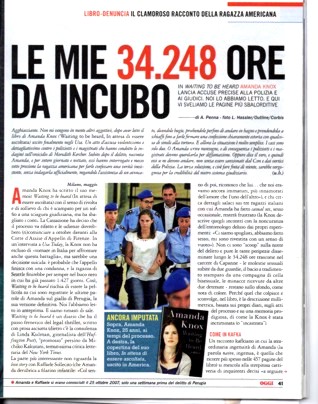
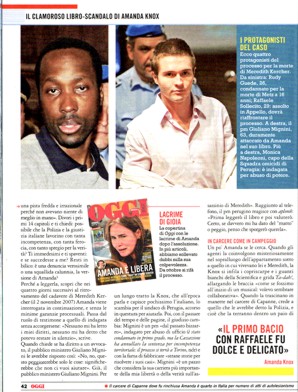
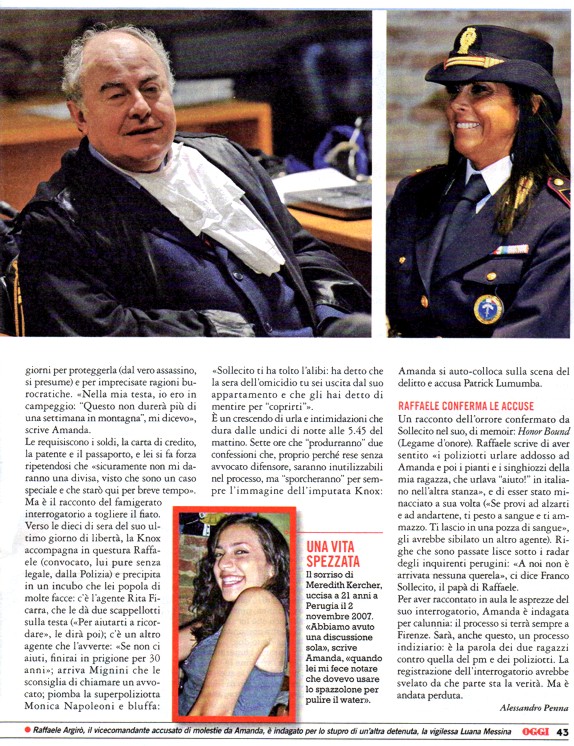
Thursday, May 09, 2013
Demonizations By Knox: She Invents An Illegal Interrogation By Mignini That Never Took Place
Posted by Our Main Posters

[The Perugia Central Police Station where Knox’s imaginary interrogation “took place”]
It is hard to imagine a more extreme form of contempt of court than Knox falsely accusing a respected prosecutor of interrogating her without her lawyer being present, and pressing her to incriminate others.
For this alone, Knox will certainly be investigated and charged. No wonder she is “scared” of returning to Italy. Apart from fears of getting up on the stand, she has lied about and falsely accused way too many people there.
1. What actually happened at Knox’s witness and suspect interviews:
Here is the true account, which has many witnesses, and then her account in the book, which has none.
Before 3:00 AM on 6 November 2007 the respected senior prosecutor Giuliano Mignini had barely set eyes on Amanda Knox.
At that point in time, she had just passed through a purely voluntary witness questioning with the police, who were actually much further ahead in questioning Sollecito and Knox’s flatmates and Meredith’s English friends.
Dr Mignini was at home asleep, but on call if the central police station needed him that night, which is how quite by chance he came face to face with Knox not long before dawn.
Knox’s latest alibi had just been collapsed in another witness interview room. Sollecito had collapsed their joint alibi almost instantly when shown phone records that proved he had just lied. He then declared their current alibi to be a pack of lies.
Told of this, Knox then floundered for a new explanation, turning finally to fingering her employer Patrick Lumumba who the police did not even know to exist until her phone record showed he did.
Police took down that statement, Knox signed it, and this at 3:00 am was the state of play.
Knox was in a waiting room and not under arrest. Mignini was required to warn Knox of her rights as a new suspect, and to warn her to do no further talking to him or anyone else around without a lawyer present.
This was especially so as Knox was inclining to babble on and on and officers were trying to calm her down. As the police had just found (and as her own lawyers later found) she can prove very difficult to stop.
This relatively brief meeting (in which Mignini made quite clear who he was, witnesses confirm) was extended to allow Knox to fine-tune her accusation of Patrick.
She shrugged off the right to have her lawyer there. Prior to this, Knox to Mignini was simply one of a whole lot of people who might be of interest, nothing more.
2. Knox’s invented version of the witness interview which never happened
This interrogation quoted from Knox’s book below is already attracting serious attention in Italy. Why? Because its just not her babbley tone, and because it never even took place.
Amanda Knox, Waiting To Be Heard, HarperCollins, Pages 90-92
[Description is of the end of Knox’s voluntary witness interview with police which Mignini did not attend; the most damaging claims are in bold]
Eventually they told me the pubblico ministero would be coming in.I didn’t know this translated as prosecutor, or that this was the magistrate that Rita Ficarra had been referring to a few days earlier when she said they’d have to wait to see what he said, to see if I could go to Germany.
I thought the “public minister” was the mayor or someone in a similarly high “public” position in the town and that somehow he would help me.
They said, “You need to talk to the pubblico ministero about what you remember.”
I told them, “I don’t feel like this is remembering. I’m really confused right now.” I even told them, “I don’t remember this. I can imagine this happening, and I’m not sure if it’s a memory or if I’m making this up, but this is what’s coming to mind and I don’t know. I just don’t know.”
They said, “Your memories will come back. It’s the truth. Just wait and your memories will come back.”
The pubblico ministero came in.
Before he started questioning me, I said, “Look, I’m really confused, and I don’t know what I’m remembering, and it doesn’t seem right.”
One of the other police officers said, “We’ll work through it.”
Despite the emotional sieve I’d just been squeezed through, it occurred to me that I was a witness and this was official testimony, that maybe I should have a lawyer. “Do I need a lawyer?” I asked.
He said, “No, no, that will only make it worse. It will make it seem like you don’t want to help us.”
It was a much more solemn, official affair than my earlier questioning had been, though the pubblico ministero was asking me the same questions as before: “What happened? What did you see?”
I said, “I didn’t see anything.”
“What do you mean you didn’t see anything? When did you meet him?”
“I don’t know,” I said.
“Where did you meet him?”
“I think by the basketball court.” I had imagined the basketball court in Piazza Grimana, just across the street from the University for Foreigners.
“I have an image of the basketball court in Piazza Grimana near my house.”
“What was he wearing?”
“I don’t know.”
“Was he wearing a jacket?”
“I think so.”
“What color was it?”
“I think it was brown.”
“What did he do?”
“I don’t know.”
“What do you mean you don’t know?”
“I’m confused!”
“Are you scared of him?”
“I guess.”I felt as if I were almost in a trance. The pubblico ministero led me through the scenario, and I meekly agreed to his suggestions.
“This is what happened, right? You met him?”
“I guess so.”
“Where did you meet?”
“I don’t know. I guess at the basketball court.”
“You went to the house?”
“I guess so.”
“Was Meredith in the house?”
“I don’t remember.”
“Did Patrick go in there?”
“I don’t know, I guess so.”
“Where were you?”
“I don’t know. I guess in the kitchen.”
“Did you hear Meredith screaming?”
“I don’t know.”
“How could you not hear Meredith screaming?”
“I don’t know. Maybe I covered my ears. I don’t know, I don’t know if I’m just imagining this. I’m trying to remember, and you’re telling me I need to remember, but I don’t know. This doesn’t feel right.”
He said, “No, remember. Remember what happened.”
“I don’t know.”At that moment, with the pubblico ministero raining questions down on me, I covered my ears so I could drown him out.
He said, “Did you hear her scream?”
I said, “I think so.”My account was written up in Italian and he said, “This is what we wrote down. Sign it.”
To repeat, Mignini was not even present at the midnight interrogation of Knox by the police, and he certainly never edged her into fingering Lumumba as is being claimed here. Knox herself did that all by herself in the presence of the police.
And she did it again and again. Emphatically.
[Dalla Vedova and Ghirga: did they illegally allow Knox to commit serious felonies in the book?]
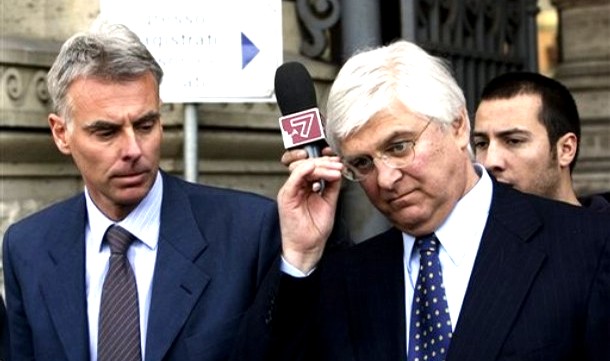
Wednesday, May 01, 2013
A Welcome To New Arrivals: A Second Experienced Lawyer Recommends How To Zero In On The Truth
Posted by James Raper With Kermit
Some Questions
My legal colleague Some Alibi hammers home in the post below that the trial jury were not fools. They decided for guilt unanimously, based on many compelling evidence points.
(1) Do you know how many hard evidence points there are? Literally hundreds. This is a very evidence-heavy case. And at trial in 2009 the prosecution did an excellent job. Between February and June, in about a dozen one-day sessions, they presented an overwhelming case and tied together all the points.
(2) Do you know how many conclusive evidence points are required for a finding of guilt? Just ONE. If it is definitive enough, a single piece of evidence can decide any case. Some Alibi posted a damning footprint example the other day which BY ITSELF could have seen Sollecito convicted in any UK or US court. There are examples too for Knox.
(3) Do you know how many evidence points were discredited during the trial and the anulled appeal? In fact it was NONE. A spooked defence kept well away from the alibi evidence, the cellphone evidence, the computer evidence, the mixed-blood evidence, the obvious crime-scene re-arrangement, and most eye-witness evidence. <
Please click here for more
A Welcome To New Arrivals #1: An Experienced Trial Lawyer Recommends How To Zero In On the Truth DRAFT
Posted by Some Alibi

[Merediths window is seen on the top floor of the house in the lower foreground]
Welcome To Common Sense
This briefing was first posted with slightly different opening paras at the start of the annulled Hellmann appeal. New arrivals often tell us this helped them the most.
If you’ve come to this website because of the Amanda Knox book and interview, then welcome. Like all of us who come to this case, you have one key question: did they do it? The Knox book and interview seriously cherrypick the case, and perhaps haven’t helped you at all.
On the Internet, you will find people who are passionate in their defence of Amanda Knox and Raffaele Sollecito; and you will find people who are passionate in their support of an exceptionally talented girl who died, of a fine justice system previously untainted by PR, and of the prosecution’s very strong case.
Please click here for more
Although The YouTube Trailer Suggests Diane Sawyer Wimped Out And Turned All Mushy…
Posted by Peter Quennell

It could still be wrong. Trailers have been misleading before.
The interview is tonight at 10:00 on ABC. Our Main Posters Kermit and Media Watcher both have tips that could still win Diane Sawyer Pulitzer Prizes.
- Media Watcher: Diane Sawyer Interview With Amanda Knox: How To Push Back Against The False Claims And Emotion
- Kermit Powerpoint: Diane Sawyer’s Very Tough Interview With Amanda Knox: ABC Kindly Shares A Sneak Preview!
Here’s hoping. Even for Amanda Knox, our advice is usually the best. We’ll carry some sort of report on this tomorrow.
Monday, April 08, 2013
Experienced Trial Lawyer: There’s Far More Evidence Than UK/US Courts Need For Guilt
Posted by SomeAlibi
The false claim “there is no evidence”
Some amateur supporters of Knox and Sollecito have committed thousands of hours online to try and blur and obfuscate the facts of the case in front of the general public.
Their goal is simple: to create an overwhelming meme that there is “no evidence” against the accused, and thereby try to create a groundswell of support. Curt Knox and Edda Mellas and Ted Simon have all made this “no evidence” claim many times.
At least some some of the media have eagerly swallowed it.
The amateur PR flunkies make up myriad alternate versions of what created single points of evidence, often xenophobic scare stories designed to trigger emotional reactions, which they hope will be repeated often enough to become accepted as “the truth”.
And where things get really tricky, another time honored tactic is to go on at great length about irrelevant details, essentially to filibuster, in the hope that general observers will lose patience with trying to work it all out.
But time and again we have shown there is actually a great deal of evidence.
Evidence is the raw stuff of criminal cases. Let me speak here as a lawyer. Do you know how many evidence points are required to prove Guilt? One evidence point if it is definitive.
A definitive evidence point
If you’re new to this case or undecided, what is an easy example of ONE definitive evidence item that might stand alone? Might quickly, simply, and overwhelmingly convince you to invest more time into understanding the real evidence, not that distorted by the PR campaign?
In fact we have quite a choice. See the footprint which was second on that list.
Now see the table above. I recommend the use of this table of measurement to avoid the lengthy back and forward of narrative argument which so lends itself to obscuring the truth. I would like to present you with this single table of measurements to give you pause to question whether this line that there is “no evidence” is really true or whether it might be a crafted deception.
I present here a summarized view of critical evidence which suggests with devastating clarity that Raffaele Sollecito was present the night of the murder of Meredith Kercher. No lengthy text, no alternate versions, just measurements.
This FIRMLY places Sollecito in the very room where Meredith was attacked and killed.
In the small bathroom right next to Meredith’s bedroom was a bathmat. On it was found a bloody naked right footprint of someone walking straight towards the shower in the bathroom. The blood is that of Meredith.
The footprint is not Amanda Knox’s - it is too big - but we can compare it to the prints taken of Rudy Guede and Raffaele Sollecito.
In Judge Massei’s report the multiple measurements were detailed in the narrative over many sentences and, in that form, their immediate cumulative impact is less obvious. It is only by tabulating them, that we are forcefully hit by not one but two clear impressions:
The measurements are extremely highly correlated to the right foot of Raffaele Sollecito in twelve separate individual measurements. In themselves they would be enough for a verdict of guilt in all but a few court cases.
But they also show a manifest LACK of correlation to the right foot of Rudy Guede, the only other male in that cottage on the night. Have a look for yourself.
If you were the prosecution, or indeed the jury, and you saw these measurements of Raffaele’s foot versus the print, what would you think? Answer the question for yourself based on the evidence admitted to court.
Then, if you compare further, exactly how plausible do you find it that the measurements of the bloody imprint are Rudy Guede’s instead?
Not only are some of the individual measurements of Rudy’s imprint as much as 30% too small, but the relative proportions of length and breadth measurements are entirely wrong as well, both undershooting and overshooting by a large margin (70% to 150%).
Conclusions that must follow
Presented with those numbers, would you consider those measurements of Rudy Guede’s right foot to show any credible correlation to those of the footprint on the mat?
Supporters of the two have tried frantically to create smoke screen around this - the wrong technique was used they say (ruled not so by the court) / they are the wrong measurements (all 32 of them? that Raffaele’s are matching exactly or within a millimetre but Rudy’s are out by as much as -30% to +50%...?).
The severity of the impact on the defence is such that there was even a distorted photoshopped version circulated by online supporters of Raffaele and Amanda until they were caught out early on in coverage. But it is hopeless, because these are pure measurement taken against a scale that was presented in court and the data sits before you.
Have a look at the measurements and understand this was evidence presented in court. Whose foot do you think was in that bathroom that night? Rudy Guede? Or was it Raffaele Sollecito on twelve counts of measurement?
And if you find for the latter, you must consider very seriously what that tells you both about the idea there is “no evidence” in this case and who was in the cottage that night…
Monday, April 01, 2013
Alarm Bells Ignored: Overconfident PR And Lawyers May Have Led To That Shock At Cassation Outcome
Posted by Our Main Posters
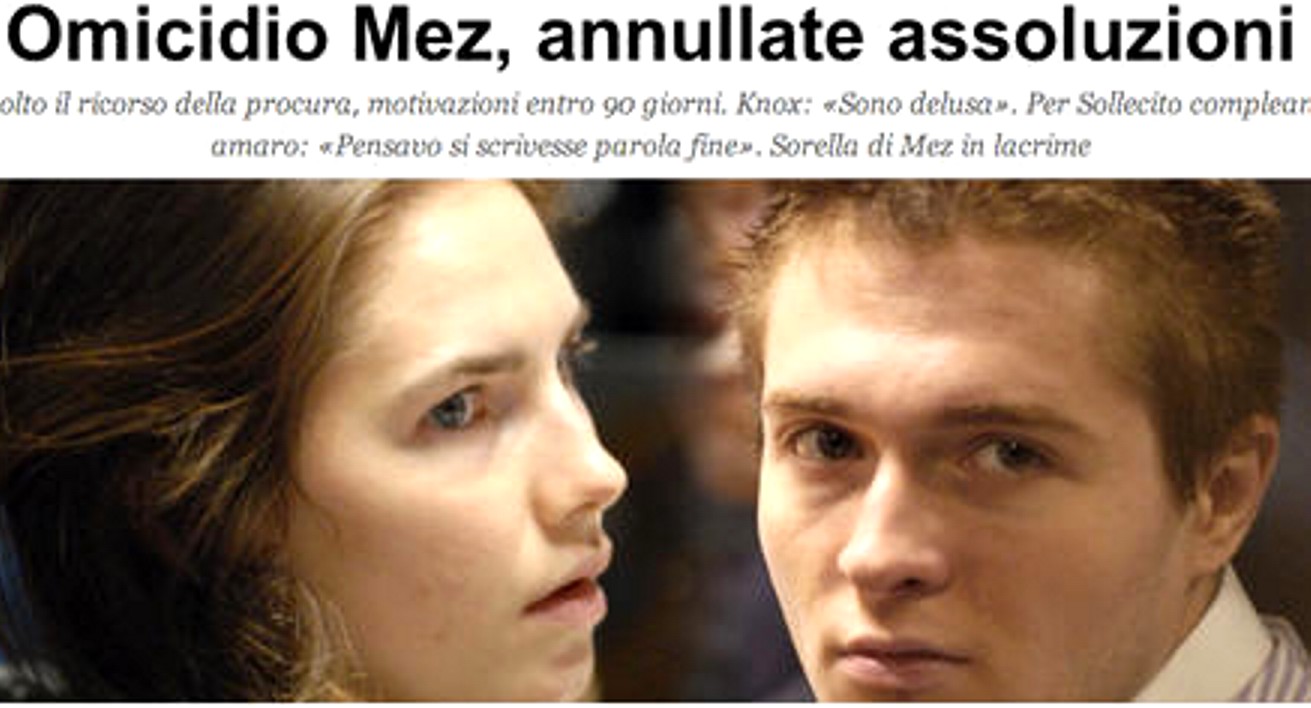
Amanda Knox has seemed to us more stunned than confident since she got out of Capanne. Her father mentioned that she was not given the whole picture there.
But we have been surprised in recent weeks at how the defense lawyers and spokesmen and especially Raffaele Sollecito and Giulia Bongoirno and Carlo Dalla Vedova and the PR flunkies were seemingly seeing the Supreme Court appeal as a forgone conclusion in their favor, a blip requiring no change in the end game.
Here are 20 warning bells that we think they might have missed or heard wrongly which contributed to a shocked and ill-prepared reaction to the Cassation ruling, and each of which a team of hard-nosed lawyers not befuddled by PR might have heard and responded to quite differently.
- 1. The Italian media in 2007-2008 in fact did not blow the case and Knox herself out of all proportion. Most of the lurid headlines appeared in the UK press where they had zero effect on the 2009 jury. There really was a hard case to answer.
2. The British and American media mostly came to be manipulated on the lines Barbie Nadeau’s book described, which meant a big contrast opened up between hard Italian reporting and fantastical UK and US reporting.
3. The Knox and Sollecito teams shrugged off a short-form trial in October 2008 at which point they might have pleaded that Meredith’s murder was not intended and drugs and mental quirks had resulted in a terrible but unintended outcome, perhaps providing relief both for themselves and Meredith’s family.
4. The prosecution part of the trial in 2009 was in fact, contrary to frequent illusory claims, fast and comprehensive and decisive, and it may have been at the end of that phase that the jury was already ready to vote guilty.
5. The defense part of the trial was far less successful with Amanda Knox on the stand suggesting to Italians that she was cold-blooded and uncaring, and from then on the defenses were desultory and dispirited with no strong points ever landed. Several days one or other of them failed to show.
6. The prosecution summation at end of trial was extremely powerful and included in it was a very convincing 15-minute crime-scene recreation video (never released to the public) which accounted for all the marks and stains in Meredith’s room and on her body by an attack group of three.
7. The Massei report, again contrary to frequent illusory claims later, was considered by those familiar with such reports a model of good logic and reasonable assumptions. It laid out and connected hundreds of evidence points which in a normal appeal process would have been unassailable.
8. The 2011 appeal did not happen because Massei was riddled with legal errors and wrong assumptions, which would have been the criteria for any British or American judge to agree to such an appeal. It happened solely because, unique to Italy, such appeals are automatic if demanded, resulting in a huge number of appeals on weak grounds.
9. Italy does not have a terrible record of trial reversals as some claim. It has a record of fine-tuning and adjustments of thousands of appeals by appeal juries seemingly wishing to prove that they are being diligent. Cassation is aware of this quirky systemic effect, and it often bounces back appeal outcomes to dead center.
10. It had appeared that the PR effort was joined by a lot of influential “heavies” including MP Girlanda, Judge Heavey, Senator Cantwell, Joel Simon of CPJ, and the billionaire Donald Trump. Most had limited positive effect in the US and less in Italy, and have been quiet since the Cassation ruling.
11. Judge Hellmann was a surprise replacement for Judge Chiari, then the able and experienced head of the criminal division. (He resigned over this.) Judge Hellmann, a good civil judge, had very limited criminal-case experience. Chief Judge De Nunzio has not explained why he replaced Chiari .
12. The scope of appeals is carefully laid out in the Italian judicial code, and they are not to be repeat trials with overall reconsideration of all evidence and al witnesses only absent the careful presentation process and cross-examination at trial. In the US or UK the defense grounds for appeal might simply have been rejected.
13. Prosecutor Mignini was provisionally convicted in March 2011 of abuse of office, but careful examination would have revealed that the grounds were spurious and he had no need of a conviction in this case. Cassation in the past month has killed his own case terminally and chastized those who brought it.
14. Incriminating DNA was found in Meredith’s room and also outside it in many locations, and also on a knife in Sollecito’s apartment. DNA consultants were “illegally” appointed who muddied the waters but decisively disproved none of it.
15. The Supreme Court is on record as deciding that three perpetrators attacked Meredith. The defenses never set out to prove Guede was a lone wolf attacker, for a long list of reasons, and they failed to prove that jailhouse witnesses Alessi and Aviello had pointed out credible alternatives.
16. The Hellmann-Zanetti report surprised a majority of Italian lawyers who read it for its passion and broad scope and tendentious logic, and for misunderstanding certain key legal concepts. Some instantly saw it as having feet of clay, and a pretty sure candidate for reversal.
17. The significance of Chief Prosecutor Dr Galati in the process seemed seriously discounted. UK and US media mostly ignored his appointment and where he came from, which was in fact Cassation in Rome where he was a highly effective Deputy Chief Prosecutor.
18. The Galati appeal itself was extremely competent and hard line and targeted the Hellmann appeal outcome in several levels or layers in a total of ten points. It is one of the toughest and most sweeping appeals ever filed in Italy, and in the US or UK alarm bells really would have gone off at this one.
19. Sollecito’s book was seemingly okayed by his lawyers, although it causes them major complications in three respects: it introduces new “facts” which contradict his own defense; it derides Italian officials and accuses them of crimes; and it looks like a seedy attempt to make money out of a crime for which the writer is still on trial.
20. While Sollecito had been acting happily oblivious and super-confident in recent months, he has added to Amanda Knox’s own problems by semi selling her out in his book, and by waking the new 800 pound gorilla of contempt of court prosecutions for not respecting the judicial process.
It may not surprise you to learn that Giulia Bongiorno has not had a very winning record at Cassation, and as far as we know the other lawyers have no experience of winning there at all.

